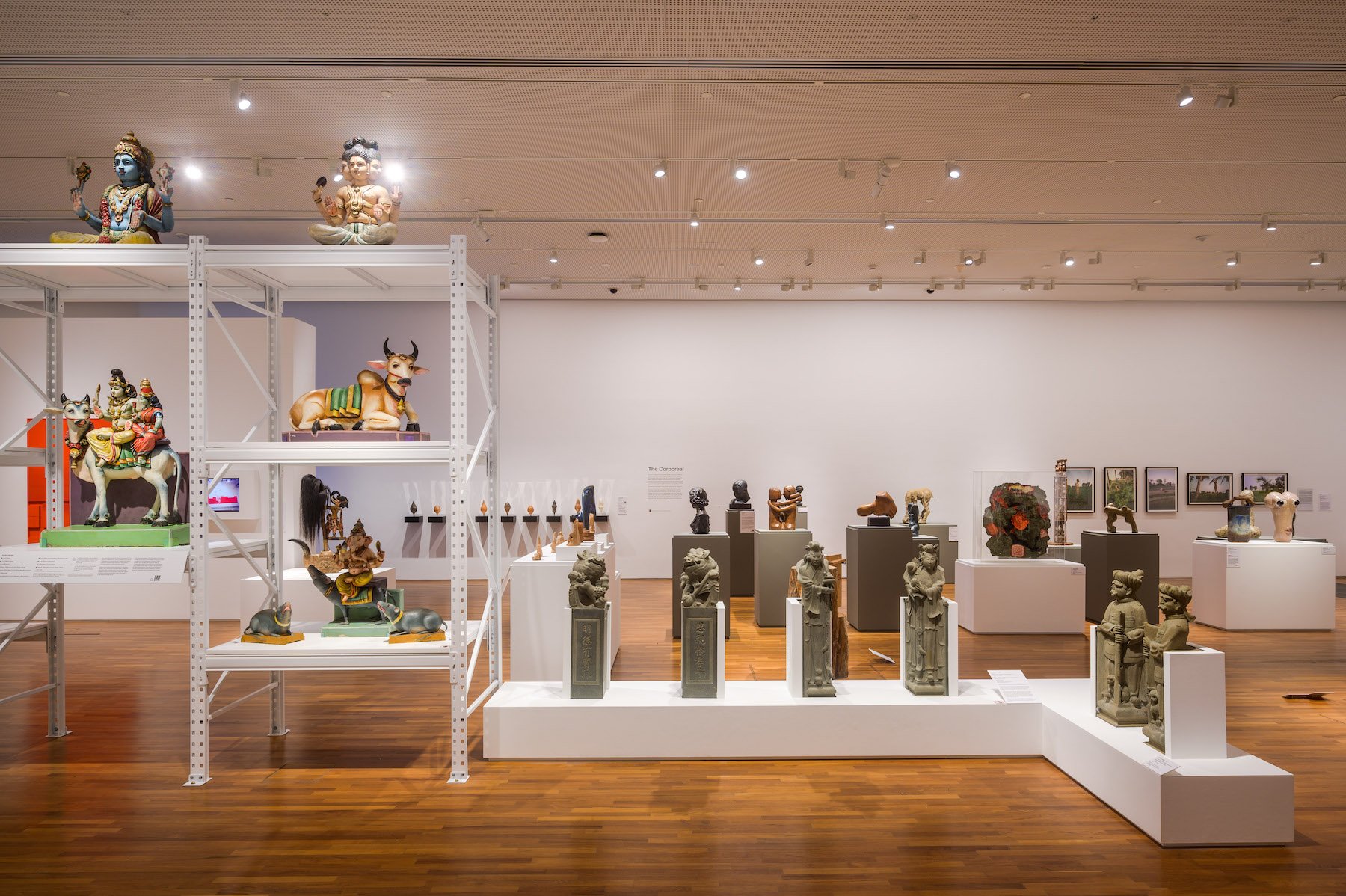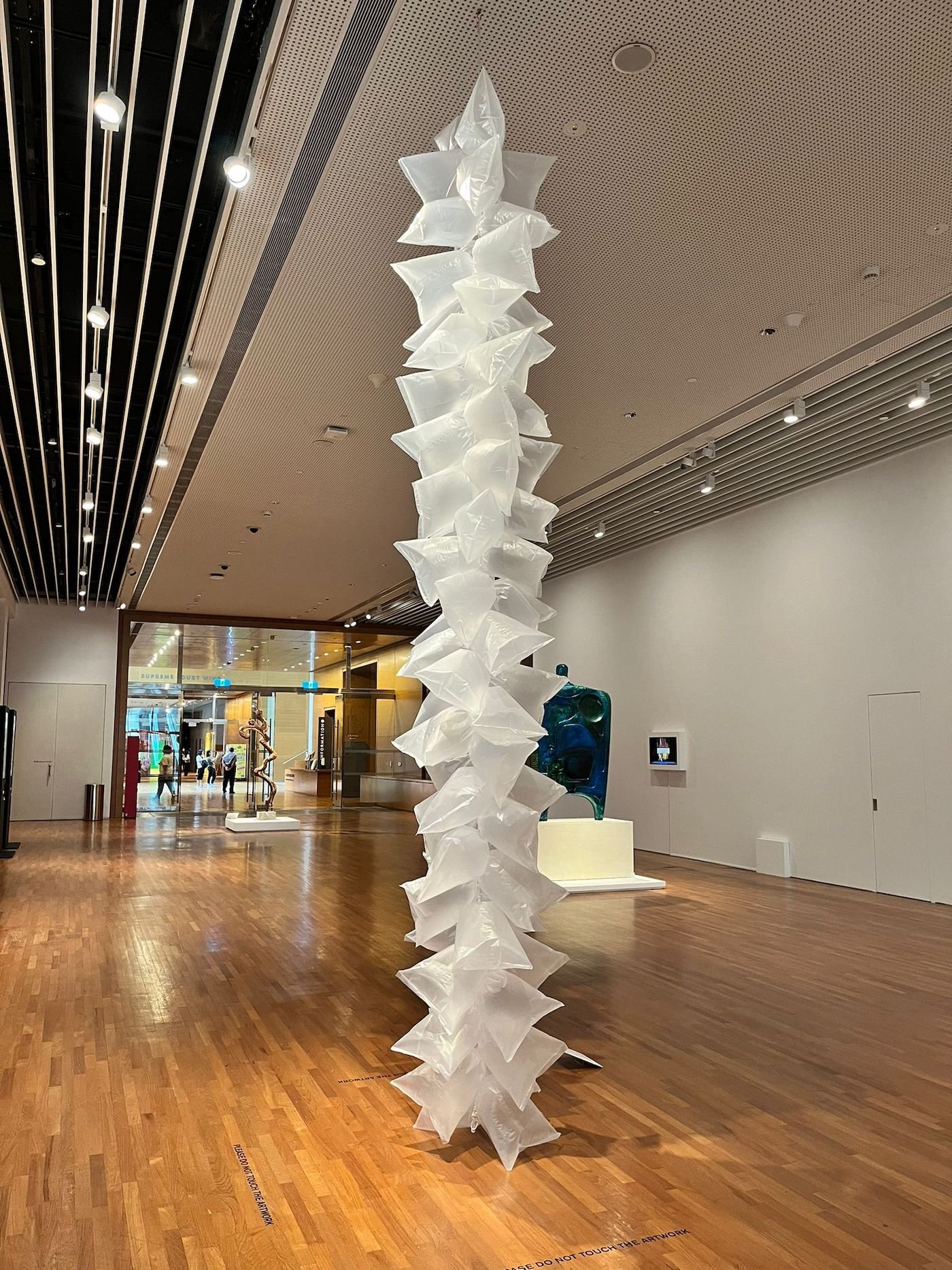Review of ‘Nothing is Forever’ at NGS
A welcomed shift in curatorial sensibility
By Ian Tee
Installation view, ‘Nothing is Forever: Rethinking Sculpture in Singapore’, National Gallery Singapore, 2022. Image courtesy of National Gallery Singapore.
The National Gallery Singapore’s latest sculpture show ‘Nothing is Forever: Rethinking Sculpture in Singapore’ (2022) is a highly anticipated one and there are good reasons for the fanfare. It is more than 30 years since the last major survey exhibition of sculpture held at a national institution, which was curated by T.K. Sabapathy in 1991 at the National Museum Art Gallery. As its subtitle suggests, ‘Nothing is Forever’ aims to unpack the development of sculpture in Singapore and the ways artists have challenged assumptions about the genre. It puts a very simple question at its core: what is sculpture? This exhibition stands out because it is able to make a compelling case for why this question matters.
Installation view, ‘Nothing is Forever: Rethinking Sculpture in Singapore’, National Gallery Singapore, 2022. Image courtesy of National Gallery Singapore.
Kumari Nahappan, 'Almanac Series #01-04-Campbell Lane to Tank Road', 1991, acrylic paint, canvas, wood and copper alloy, dimensions variable. Exhibition view in ‘Nothing is Forever: Rethinking Sculpture in Singapore’. Collection of Singapore Art Museum. Image courtesy of National Gallery Singapore.
Here, I would like to preface my interest in penning this review. There seems to be a shift in sensibility in ‘Nothing is Forever’ which left a deep impression, even after multiple visits. This shift can be detected in two key ways: firstly, in the exhibition experience especially for regular visitors to the Gallery; and secondly, in the treatment of its curatorial premise.
These two aspects come together in what the curators describe as an “open exhibition layout”, partly inspired by the storage systems used to house Singapore's national collections at the Heritage Conservation Centre. It is a novel mode of presentation that immediately sets a unique tone in the space. Temple figurines and funerary statuary are presented alongside works by modern and contemporary Singapore artists. The sheer number of objects packed into the gallery is also striking. There is just so much to see: a cacophony of materials and textures of different scales, displayed at different heights.
However, this is an organised mass. The show explores its central question along four themes: ‘Power’, ‘The Spiritual’, ‘The Corporeal’ and ‘Making, Unmaking, Remaking’. In many ways, the exhibition reads like the curatorial essay laid out spatially. These key ideas are well communicated to audiences through friendly wall texts, and the open layout encourages one to see how the themes intersect.
Installation view, ‘Nothing is Forever: Rethinking Sculpture in Singapore’, National Gallery Singapore, 2022. Image courtesy of National Gallery Singapore.
Installation view, ‘Nothing is Forever: Rethinking Sculpture in Singapore’, National Gallery Singapore, 2022. Image courtesy of National Gallery Singapore.
That said, the exhibition layout is not without its flaws. At times, aesthetics is traded for efficiency or practicality. As a result, the installation of certain artworks looks compromised. For example, Kim Lim’s ‘Steps’ (1967) and Han Sai Por’s ‘Tetrahedron-tetrahedron Interpenetration’ (1993) seem to function primarily as case studies among the cluster of white monochromatic works, which is a shame because they are highly elegant sculptures. The decision to display ‘Steps’ against the wall is particularly unfortunate as it completely flattens the sculpture, blending it into the background.
I also wish for more beauty and coherence in the corridor space given to large-scale works as it seems like the only trait connecting this group of works is their size. While I appreciate the intention to evoke the feeling of a sculpture park, what is missing is an interaction between the sculptures and the architecture. The pieces that look great are those that respond to the space or echo the materials and textures found in it, such as Lim Leong Seng’s ‘New Era’ (1976), Tang Da Wu’s ‘Cloud of ‘68’ (1971, remade 2022) and Vincent Hoisington’s ‘Entrepreneur’ (undated).
Lim Leong Seng, 'New Era', 1976, plastic bags, rubber bands and air, dimensions variable. Exhibition view in ‘Nothing is Forever: Rethinking Sculpture in Singapore’. Collection of National Gallery Singapore. Image courtesy of National Gallery Singapore.
Tang Da Wu, ‘Cloud of ‘68’, 1971 remade 2022, bricks, barb wire, steel wire and metal plates, dimensions variable. Collection of the artist. Image courtesy of National Gallery Singapore.
Installation view, ‘Nothing is Forever: Rethinking Sculpture in Singapore’, National Gallery Singapore, 2022. Image courtesy of National Gallery Singapore.
Despite the shortcomings, I welcome such attempts at creating new exhibition experiences. Regardless of the outcome, they keep both exhibition organisers and goers on their toes.
It is crucial to translate the excitement of new curatorial ideas into the art of exhibition-making. I say this because the exhibition as a platform and audience engagement should not be taken for granted. How does an exhibition add value in a manner that an essay cannot satisfy? Why should a visitor care about what is being said about the objects on display? In an ideal scenario, the curator/ exhibition-maker, artists and audience need to all have their skin in the game.
“ It is crucial to translate the excitement of new curatorial ideas into the art of exhibition-making. I say this because the exhibition as a platform and audience engagement should not be taken for granted. How does an exhibition add value in a manner that an essay cannot satisfy? Why should a visitor care about what is being said about the objects on display? In an ideal scenario, the curator/ exhibition-maker, artists and audience need to all have their skin in the game. ”
One way ‘Nothing is Forever’ has laid out the stakes in the exhibition’s central question is by asking if temple figurines and funerary statuary can be considered as sculptures. The gesture of including them in this exhibition is not only visually provocative but also enmeshes the discursive and exhibitionary histories of sculpture in Singapore. The curatorial essay expounds on how the show is built upon existing ideas and attempts to address historical blind spots. As such, even though the exhibition is richly grounded in research, it is not esoteric in its outlook. By bringing the question of sculpture into the context of ordinary life and Singapore’s cultural heritage, the layperson can participate in this discussion too. As elementary as it sounds, I find this approach exciting and inspiring.
‘Nothing is Forever: Rethinking Sculpture in Singapore’ is on view at National Gallery Singapore, from 29 July 2022 to 5 February 2023.

















